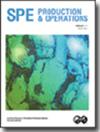使用远场分流器缓解页岩地层中母井和注入井裂缝的相互作用
IF 1.4
4区 工程技术
Q2 ENGINEERING, PETROLEUM
引用次数: 3
摘要
页岩填充井的水力压裂处理经常受到现有母井枯竭和不对称裂缝生长的影响。这些现象可能会导致主井的超载产水、支撑剂沉积和套管变形,以及对填充井的不平衡增产。本研究确定了颗粒材料(即远场转移剂)通过在主要骨折翼的末端附近桥接来减轻上述负面结果的有效性。建立裂缝扩展模型,以表征应力耗尽环境下裂缝末端的宽度剖面。采用一种开槽盘装置来评估和优化颗粒混合物,以桥接具有代表性的裂缝宽度。通过模拟井下环境的流变试验,设计了一套转移材料的系统。对30口母井511次压裂命中的关键治理指标进行了统计分析,分为分流剂类型和击中后母井状态。将受影响井的生产趋势与特定区域类型曲线和未进行暂堵剂试验的邻井进行了比较。在模拟和测试结果的基础上,在页岩区对两种类型的高分级远场暂堵剂进行了现场测试:可溶解的极细颗粒与100目砂混合,以及325目硅粉与100目砂的混合物。在压裂现场收集的支撑剂粉尘也进行了评估,以取代商业二氧化硅粉。与不使用远场暂堵剂的基本情况相比,上述暂堵体系的高分级共混体系表现出了更好的裂缝冲击和产能指标。二氧化硅粉和100目砂的混合物的性能与更昂贵的可溶解细颗粒和100目砂的混合物相当。硼酸交联瓜尔胶是一种有效的携带液,可将转移材料输送到骨折端。对裂缝冲击事件的统计分析表明,应用远场暂堵剂并没有降低裂缝冲击期间的压力累积幅度;然而,它显著增加了母井的击后压降率。在特定区域类型曲线的基础上,与不使用暂堵剂的基本情况相比,泵入远场暂堵剂可使P50估计最终采收率(EUR)提高约6%。对于所有受远场暂堵剂影响的井,与母井相比,填充井的收益更大,增加了约7%的50欧元。本文章由计算机程序翻译,如有差异,请以英文原文为准。
Use of Far-Field Diverters To Mitigate Parent- and Infill-Well-Fracture Interactions in Shale Formations
Hydraulic-fracturing treatments in shale infill wells are often impacted by existing parent-well depletion and asymmetrical fracture growth. These phenomena can result in excessive load-water production, deposition of proppant and deformation of casing in the parent well, and unbalanced stimulation of infill wells. This study determines the effectiveness of particulate materials (i.e., far-field diverting agents) for mitigating the above negative outcomes by bridging near the extremities of dominant fracture wings.
Fracture propagation was modeled to characterize the width profile at fracture extremities in a depleted-stress environment. A slotted-disk device was used to evaluate and optimize particulate blends for bridging slots representative of width near the fracture tip. Rheological tests replicating the downhole environment were used to formulate a system for transporting the diverting materials. Statistical analysis of 511 fracture hits at 30 parent wells was performed on key treatment indicators by the category of diverter type and post-hit parent-well condition. Production trends of the influenced wells were compared to area-specific type curves and offset wells without diverter trials.
On the basis of the simulation and testing results, two types of high-graded far-field diverter systems were field-tested in a shale play: dissolvable, extremely fine particulate mixed with a 100-mesh sand, and mixtures of a nominal 325-mesh silica flour and a 100-mesh sand. Proppant dust collected at the fracturing site was also evaluated for replacing commercial silica flour. High-graded blends of the above diverting systems demonstrated superior fracture-hit and productivity metrics as compared to the base case of not applying far-field diverters. The silica flour and 100-mesh-sand mixture performed on a par with the significantly more expensive blend of dissolvable fine particulate and 100-mesh sand. Borate-crosslinked-guar gel was an effective carrying fluid for transporting diverting materials to the fracture extremities.
Statistical analysis of fracture-hit events shows that the application of far-field diverters did not reduce the magnitude of pressure buildups during fracture hits; however, it significantly increases the post-hit pressure-falloff rate at the parent wells. On the basis of the area-specific type curves, pumping far-field diverters increased the P50 estimated ultimate recovery (EUR) by approximately 6% compared with the base cases of not applying diverters. For all the wells impacted by far-field diverters, the infill wells saw larger benefits with an increment of P50 EUR by approximately 7% compared with the parent wells.
求助全文
通过发布文献求助,成功后即可免费获取论文全文。
去求助
来源期刊

Spe Production & Operations
工程技术-工程:石油
CiteScore
3.70
自引率
8.30%
发文量
54
审稿时长
3 months
期刊介绍:
SPE Production & Operations includes papers on production operations, artificial lift, downhole equipment, formation damage control, multiphase flow, workovers, stimulation, facility design and operations, water treatment, project management, construction methods and equipment, and related PFC systems and emerging technologies.
 求助内容:
求助内容: 应助结果提醒方式:
应助结果提醒方式:


